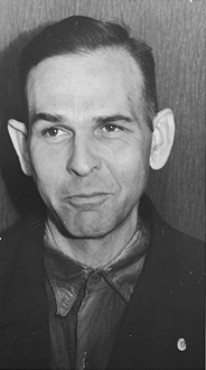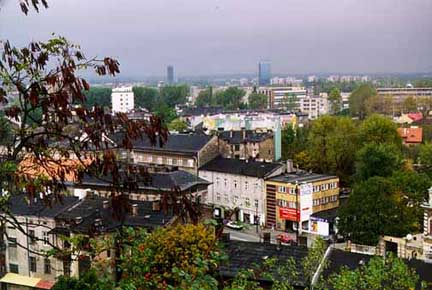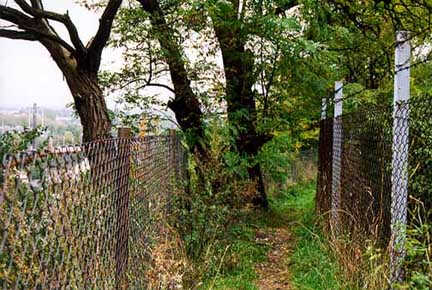Podgorze Ghetto
After the Wannsee conference on Jan.
20, 1942, at which the "The Final Solution to the Jewish
Question" was planned, the Nazis began the "transportation
to the east" of 11,000 Jews from the Podgorze Ghetto to
the extermination camp at Belzec on the eastern border of German-occupied
Poland. There were two separate actions in June 1942 and October
1942 when Jews from the Podgorze Ghetto were rounded up and sent
to the Belzec extermination camp. The movie Schindler's List
combines these actions and the final liquidation of the Ghetto
in 1943 into one scene.
 German soldier kicks
a Jew who is being forced onto a truck
German soldier kicks
a Jew who is being forced onto a truck
On March 13, 1943, a Saturday, the Podgorze
ghetto was officially closed and around 6,000 Jews who were able
to work were sent to the Plaszow forced labor camp, while around
2,000 children and old people were sent to other camps, including
Auschwitz II, also known as Birkenau, which was both a labor
camp and a death camp.
The Jews had originally been invited
to settle in Poland by King Kazimierz the Great in the 14th century
after they had been expelled from Western Europe. The first Jewish
neighborhood in Krakow was south of ul. Sw. Anny in the University
district which is the location of the Jagiellonian University,
founded by King Kazimierz in 1364.
In 1495, King Jan Olbracht expelled the
Jews from the University district and compelled them to live
in a restricted area in Kazimierz. The concept of a Jewish ghetto
dates back to the 13th century, but the term ghetto did not come
into use until after 1519 when Jews in Venice were forced into
a separate neighborhood near a cannon foundry called Gheta.
In the movie Schindler's List, there
is a scene where the Commandant of Plaszow, Amon Goeth, who was
in charge of liquidating the Podgorze Ghetto in 1943, makes a
speech about the historical significance of ending six centuries
of Jewish culture in Krakow. Goeth was Austrian and Krakow was
in the Austro-Hungarian province of Galicia from 1776 until 1919
when Poland again became an independent country. Goeth had been
transferred to Plaszow after successfully liquidating the ghetto
in Lublin, which was another center of Jewish culture and also
the city which the Nazis chose for their eastern headquarters,
partly because of its history of German domination in the dim
past. Besides being an important Jewish center for centuries,
Krakow was notable as a center for liberal politics and was Lenin's
base for international communism from 1912 to 1914.
 Amon Goeth was in charge
of liquidating Podgorze Ghetto
Amon Goeth was in charge
of liquidating Podgorze Ghetto
One of the scenes in the movie Schindler's
List shows Oskar Schindler as he watches the liquidation of the
Podgorze Ghetto.
The photograph below shows the view looking
westward towards Podgorze, as seen by Oskar Schindler as he rode
his horse in Bednarskiego Park on a hill that extends from Limanowskiego
Street. In the picture, the street on which the two cars are
driving is Krakusa Street where Genia, the little girl in the
red coat, was walking in the Schindler's List story. The movie
scene was shot on this street, exactly where it happened. Krakusa
street is one block west of the Plac Zgody, where the Pharmacy
Museum is located. The park is located between the former Podgorze
Ghetto and the Plaszow district and is very close to Oskar Schindler's
factory.
 Red car on Krakusa
St. where Schindler saw the girl in a red coat
Red car on Krakusa
St. where Schindler saw the girl in a red coat
The photo below shows the bridal path
along the edge of the hill overlooking Krakusa Street, from where
Schindler looked down from his horse and saw 7,000 Jews being
marched out of the Podgorze Ghetto for transporation to concentration
camps, according to the novel, Schindler's Ark. The path is now
overgrown with trees.
 Path where Schindler
rode his horse
Path where Schindler
rode his horse
The only non-Jewish inhabitant of the
Podgorze ghetto was a master pharmacist named Tadeusz Pankiewicz.
His Eagle Pharmacy was located at #18 on the cobble-stoned Plac
Zgody which was the main square where selections took place and
from where transports of Jews were sent to Belzec. In 1993, the
same year that the movie was filmed, his pharmacy building was
turned into a National Memorial Museum. At the museum are displayed
pictures of the roundup and deportation of the Jews of Krakow
and a few religious artifacts.
In 1947, Tadeusz Pankiewicz published
his memoirs called The Pharmacy in the Krakow Ghetto. It is an
account of how his pharmacy became a meeting place for the Jews
in the ghetto where they could get information from the underground
press. Letters were sent from and received at the pharmacy. It
was also a hiding place for Jews whom the Nazis were trying to
arrest for violations of their laws. According to Schindler's
List, the pharmacy was where messages were passed between the
Jewish Combat Organization (ZOB) and the partisans of the Polish
People's Army, the two main groups which fought the Nazis in
guerrilla warfare during World War II. In the movie, Schindler's
List, there is no mention of how Jewish partisans resisted the
Nazis and helped to defeat the Germans in World War II.
|